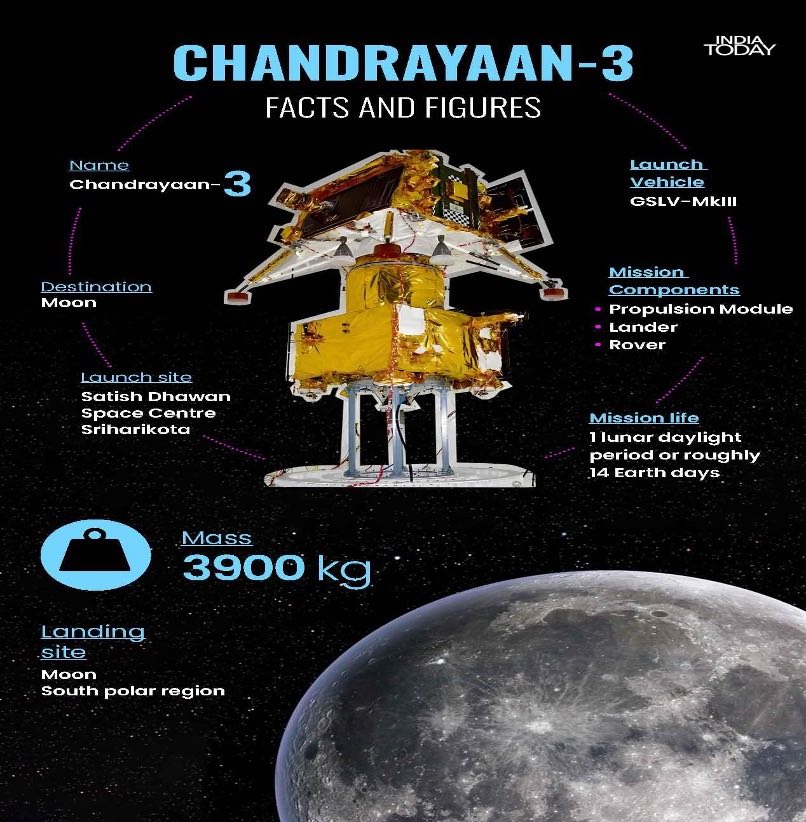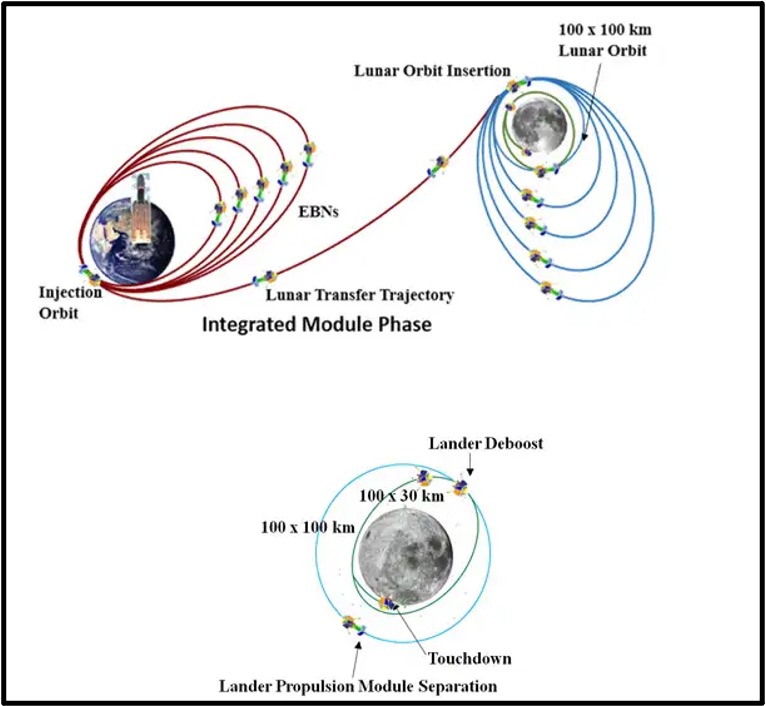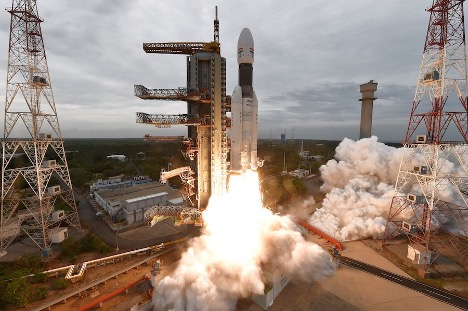All of India celebrated the successful launch of Chandrayaan 3, the third instalment in the Chandrayaan programme of ISRO at 2:35 pm IST on 14th July 2023 from Satish Dhawan Space Centre in Sriharikota, Andhra Pradesh. It has a C-25 Cryogenic Engine thrusting at a speed of 9.29 km per second. It is expected to ‘soft’ land on the moon’s surface on August 23 or 24. A soft landing implies an intact landing on the Moon’s surface without any crash, whether intentional or otherwise. It consists of a Lander Module (LM), Propulsion Module (PM) and a Rover. The final cost of the project was reported to be ₹ 615 crore.

Describing the aim and objective of the mission, ISRO has explained how the Lander will demonstrate a “safe and soft landing on the lunar surface” and signify “Rover roving on the moon”. Chemical analysis and “in-situ scientific experiments” will also be carried out. The spacecraft was launched by the Geosynchronous Satellite Launch Vehicle Marked 3, GSLV- Mk3 (LVM3 for short), which is the biggest rocket ever built in India. The design for Chandrayaan 3 is made with a failure-based approach. According to the ISRO Chief S Somanath, “Instead of a success-based design in Chandrayaan 2, we are doing a failure-based design in Chandrayaan 3. What all can fail and how to protect it- this is the approach we have taken” (HT News Desk, 2023). Chandrayaan 2 failed to achieve a soft landing on the Moon’s surface and lost contact with the ground station of ISRO when nearing landing. Working over the design and learning from previous experience, the changes in Chandrayaan 3 includes:
A simpler design and load- while Chandrayaan 2 included a Vikram Lander, Pragyan Rover, and an orbiter, Chandrayaan 3 comprises only the former two. The present Propulsion Module will have a single instrument known as ‘spectro- polarimetry of habitable planet earth’ (SHAPE), unlike the nine in-situ instruments for Chandrayaan 2.
Improved Lander feature- Chandrayaan 3 will include “Lander hazard detection and avoidance cameras” enabling coordination between orbiter and mission control.
Additional experiments- the present spacecraft includes a laser retroreflector array (LRA) to conduct experiments for understanding the lunar surface. The instruments aboard the spacecraft will conduct experiments on the Moon for a total of 14 Earth days equivalent to 196 Moon days, as one Moon Day is equal to 14 Earth days.

Days before the launch of the mission, road activities have been banned near and around the Satish Dhawan Space Centre until the date of launch. An advisory has been issued by the Tamil Nadu telecom department stating a ban on digging and construction activity. This is being done to ensure that all communication lines are open and the Chandrayaan 3 mission is launched successfully.
The Chandrayaan programme is a lunar exploration programme of ISRO that began in 2008 with the successful launch and landing of the first moon rocket, Chandrayaan 1. It was followed by Chandrayaan 2 in 2019 which proved to be partially successful. It was successfully launched into lunar orbit before the lander crash landed on the moon’s surface due to a software glitch. Chandrayaan 3 aims to be an improvement over its previous attempt. Chandrayaan 3 is mainly a “landing and roving mission” and does not include an orbiter element, unlike Chandrayaan 2.

Chandrayaan 3 is unique and the first of its kind as it will be the first to land on the Moon’s South Pole with no humans on board. Israel attempted a similar mission in April but the spacecraft faced an engine error and crashed on the Moon’s surface when landing. Planetary geochemist of the Australian National University, Marc Norman states that what the Apollo missions have explored and studied was vastly different from what Chandrayaan 3 is going to explore- “Chandrayaan 3 will provide a close-up view of an entirely new region of the Moon,” he explains (O. W. Desk, 2023). If successful, it will be a proud moment for both the organization and the nation as no country has yet been able to successfully land their spacecraft on the South Pole of the Moon. The interest of several nations to have their spacecraft land and explore the South Pole of the Moon lies in the fact that “parts of it remain permanently in shadows”, as said by ISRO. This raises further interest in the sampling of Moon ice and the possibility of the large craters near the area containing secrets of the early Solar System. Not only this, but a successful Chandrayaan 3 mission can also serve as a precursor to the Artemis III mission of the US, which is the third instalment of the Artemis programme of the US, scheduled for launch in 2025, wherein humans may go to the Moon for the first time in the coming years. Though a successful mission will lead to becoming a great feat, achieving it will not be an easy task. The South Pole is an area of concern primarily due to its difficult terrain and low temperature.
While there is a lot of hope and buzz around this lunar mission, it is not the first time that India has planned such a mission at the lunar South Pole. Chandrayaan 1 in 2008 proved the existence of water ice on the lunar surface, which was matched by a NASA instrument aboard Chandrayaan 1 orbiter. The Chandrayaan 1 impact probe was intentionally crashed into the lunar surface near the South Pole and it detected water ice just before it crashed, leading to a discovery which led to further exploration.
India is progressing and improving fast. With only a few nations dominating the space exploration and technology field, India entered the field only in 1962 when pioneer Dr Vikram Sarabhai formed the Indian National Committee for Space Research (INCOSPAR) which later got changed to ISRO in 1969. Fast forward to the present times and ISRO is one of the six largest space agencies in the world with India having one of the largest communication and remote sensing satellites. Chandrayaan 3 has again turned the focus on India and countries are waiting patiently and hopefully for its successful landing. Prime Minister Narendra Modi’s recent US visit included some significant agreement on space-related matters proving that the initiators of space programs are looking up to India and its mission, as stated by Union Minister of State (Independent Charge) for Science and Technology, Jitendra Singh. According to Pawan Chandana, CEO, and co-founder of Skyroot Aerospace, known for launching India’s first privately developed rocket, if this mission sees success, then India would be included in the list of nations to have successfully landed their craft on the moon, along with the USA, China and Russia.

A victorious moon landing will also boost the nation’s investment in the space sector while boosting employment opportunities as well. If newspaper reports are to be trusted, a few years back, the Indian space economy was valued at $9.6 billion and by 2025, EY predicts this to go up to $13 billion. Private participation is seen widely in this area for its attractive opportunities and government initiatives such as the Indian Space Policy 2023 and the Indian National Space Promotion and Authorization Centre (IN- SPACe).
With Space missions being undertaken and executed by countries all around, from finding alternative life sources on Mars to exploring the Moon, the attraction towards the Earth’s natural satellite stems from its ability to be cost-effective while providing a safe platform for launching Mars missions. Apart from these, the Moon also provides a good scope for research in the field of science as well as resource exploration.
Written by – Iesha Tandon
Edited by – Mehansh Barthwal
